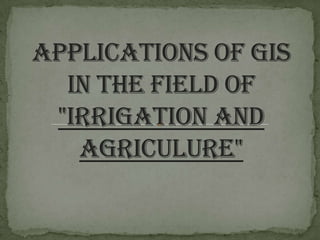Applications of gis in the field of
- 1. APPLICATIONS OF GIS IN THE FIELD OF "IRRIGATION AND AGRICULURE"
- 2. The importance of GIS is being discovered in various fields of study such as that of irrigation and agriculture. Irrigation is of primary importance in our country. a lot of factors influence the irrigation facilities and systems and the efficiency of these systems determine the agricultural outputs. This is of both economical and social importance.GIS has brought about an entirely different way of looking at problems and finding their solution. Its uses in agriculture and irrigation are innumerous.
- 3. The water availability in time and space commands the agricultural practices such as cropping pattern, calendar, etc. Such a synchronization of cultivation and irrigation is possible only when the water control in terms of adequacy, timeliness and uniformity is understood and practiced. This synchronization can be obtained by using GIS software
- 4. Remote sensing and GIS techniques are useful for Irrigation water management and agriculture in: Identifying areas suitable for cultivation
- 5. Classifying the area available on the basis of suitability of soil types for different varieties of crops.
- 6. Assessment of water availability in reservoir for optimal management of water to meet the irrigation demand.
- 7. Identifying and assessment of irrigated crops. Determination of irrigation water demand over space and time
- 8. Distinguishing lands irrigated by surface water bodies.
- 10. Water logging and salinity problems in irrigated land
- 11. Irrigation system performance evaluation This primary information on the crop and water availability derived from remote sensing methods form reliable databases for further investigation and analysis across space and time at desegregated levels of spatial parcels. This integration of remote sensing and ground inputs can be very effectively organized and analyzed in GIS environment. Such augmentation of the basic information of the system and the expert knowledge results in a system that addresses the present scenario of the system and future development in the system. One of the advantages of GIS is that it gives a clear picture of effect of any action plan employed in the system through “if-then” simulation.
- 12. All the above processes are carried out toplan new irrigation systems
- 14. improve and extend already existing systems The various types of mapping provided by RS required by GIS to be useful for irrigation and agriculture are:soil type mapping
- 17. land use mapping
- 18. contour mappingexisting irrigation system mapping
- 20. Different combinations of the above layers help in different types of relevant assessment necessary for planning, maintaining and improving irrigation systems.SOIL TYPE MAPPINGFor planning of agriculture on a broad scale it is extremely important to know different types of soils, type of crops they can support and areas having the type of soil. This information if used effectively can greatly improve the agricultural output and its quality. Some attributes of soils are: humus content, nutrient content, name etc.
- 21. CROP COVERAGE MAPPINGMaps indicating crop coverage are very useful in estimating the yield of various crops. These also help in analyzing existing methods of agriculture such as crop rotation, terracing etc. In order to bring forth any improvements, it is important to study the existing trends and methodologies.Some attributes of crops are: suitable season/ climatic conditions, water requirements, manure/ fertilizer requirements, total time for sowing reaping and harvesting etc.
- 22. RIVER/DISTRIBUTARIES MAPPING These maps show the geographical location of the different river and distributaries systems in and around an area. Knowing his is helpful in locating nearest source of water and designing of most economical canal systems.Attributes: name, volume, depth, width etc.
- 23. LAND USE MAPPING These maps give information about how the land is already being used. It helps in analyzing how effectively the land resources are being used and in coming up with more economical suggestions for the same in addition to keeping updated records used for various other calculations.Attributes: kind of usage, total forest coverage, total agricultural output of an area, estimated urbanization of an area etc.
- 24. CONTOUR MAPPINGThese maps show the elevation data of the various geographical features on the earth’s surface. This information helps us in estimating important data such as the most economical laying of canals considering cost of excavation and leveling etc.
- 25. EXISTING IRRIGATION SYSTEM MAPPINGThis kind of mapping deals with details of older or existing systems such as dams and canals. Study of this information helps in estimating how efficiently the systems work and on its basis determine the extension projects and maintenance programs.Attributes: length of systems, efficiency details, areas served, volume of water carried, benefits etc.
- 26. METEOROLOGICAL MAPPINGRainfall patterns, climatic conditions, seasonal changes and predictions are the areas dealt with under this kind of mapping. This is important information required by famers and agriculturists to plan the type of farming most suitable and economical. It also helps in estimating how much water is to be let out into the canal systems in accordance to the predictions of the rainfall intensities.
- 27. THANK YOU















